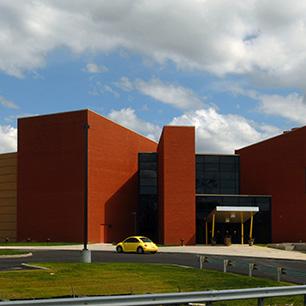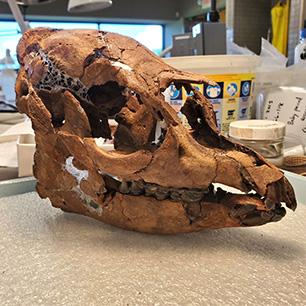In late May of 2000, fossils were discovered during a Tennessee Department of Transportation (TDOT) road construction project on the outskirts of the town of Gray in Washington County, Tennessee. It soon became apparent that the site was extremely rich with fossils unlike any known from the region, so a concerted effort of TDOT employees, researchers from the University of Tennessee Knoxville, and the TN State Archaeologist sought to protect and preserve the site. On August 7th of that year, Tennessee Governor Don Sundquist and other state officials visited the site for a first look, and during a second visit on September 15th, the governor announced that the road project would be relocated to save the fossil site for research and education.
Through the leadership of Dr. Paul Stanton, then President of East Tennessee State
University (ETSU), the Gray Fossil Site (GFS) became an ETSU project. In 2001, the
University hired paleontologist Dr. Steven Wallace to head up excavations and research.
In September of 2002, Governor Sundquist announced an $8 million Federal Highway Administration
grant to ETSU for the development of a museum and visitors center at the site, with
an additional $2 million match provided by ETSU. The museum thus began as a $10 million
investment in scientific education and outreach in East Tennessee.
Shortly after the funding announcement, ETSU founded the Don Sundquist Center of Excellence
in Paleontology with Dr. Wallace as director. The primary responsibilities of the
CoEP, via the College of Arts and Sciences, included museum development and planning;
fossil prospecting, excavation, and research; university education; and public outreach.

During these early years, Gray Fossil Site excavations and fossil preparation continued
to reveal the unique and diverse nature of the fossil deposit. In 2004, researchers
published an overview of the fauna, flora, age, geology, and paleoecology of the site
in the journal Nature. That same paper also introduced two extinct species new to
science: a badger and a red panda. This unique Appalachian panda, the first panda
ever found in the region, was named Pristinailurus bristoli after Larry Bristol, who found the first panda tooth and who was heavily involved
with GFS outreach. This early publication in Nature brought international attention
and interest to the site, and was only the beginning of the scientific discoveries
that attest to the significance of the GFS.
By 2004, the paleontology contingent at ETSU had grown and was continuing to attract
students and researchers. Geologist Dr. Mick Whitelaw had joined the ETSU faculty
in 2003 and began work on paleomagnetism and stratigraphy of the site, as well as
developing paleontology outreach programs for grade schools. Numerous volunteers and
students had joined in helping with excavations and lab processing and signing up
for paleo-related classes or field trips. In the fall of 2004, Dr. Blaine Schubert
was hired as a postdoctoral fellow to assist in museum and exhibit planning, help
manage volunteers and staff, teach classes, and oversee the organization of the growing
fossil collections.
For most of 2005 and 2006, ETSU paleontology focused primarily on museum development
operations, excavations, laboratory processing, and curation of fossils. In the fall
of 2006, the paleontology group grew considerably with the hirings of Ms. Jeanne Zavada
as Museum Director, Dr. Michael Zavada as the Chair of Biological Sciences, Dr. Yusheng
(Christopher) Liu as a faculty member in Biological Sciences, and Dr. Blaine Schubert
as a faculty member in what was then the Department of Physics, Astronomy, and Geology.
In the 2006-2007 academic year, the Museum and Center defined separate roles and became
distinct entities within the College of Arts and Sciences. In late August of 2007,
the 33,000 square foot museum opened to the public and was officially named the East
Tennessee State University and General Shale Brick Natural History Museum and Visitors
Center at the Gray Fossil Site.
In the fall of 2008, Dr. Jim Mead became the Chair of the newly developed ETSU Department
of Geosciences. Along with Dr. Mead came thousands of skeletal specimens for research
and teaching, as well as an extensive paleontology library of books and articles.
With a new department, a new Chair, and a new collection of educational assets, a
Master’s of Science in Geosciences with a concentration in Paleontology was developed.
In 2009, with its original mission and goals accomplished, the CoEP set out to accomplish
new goals. Over the following two years the Center successfully established an active
foundation account for research and education, continued cultivating a stronger relationship
with the Museum, developed a website, hosted a Gray Fossil Site Symposium, obtained
a large NSF grant for research (PIs: Wallace and Schubert), and published a book on
GFS research in 2010.
Early 2012 saw a change in the organizational structure of the Museum and Center,
with the Museum becoming a component of the Center. At this time, the Museum began
developing a strategic plan for growth, development, and sustainability, and in 2013,
the CoEP established a path forward document for the Museum. This development plan
relied on increased funding and staff to become a fully operational natural history
museum and science center.

In 2016, ETSU entered into a partnership with the Hands On! Regional Museum from downtown
Johnson City. Hands On! began the process of relocating their staff and operations
to the GFS, sharing physical space with the ETSU Gray Fossil Site & Museum and taking
on the responsibilities of marketing, front desk operations, new exhibits, ticket
sales, on-site programming, the gift shop, and general tours. By June of 2018, Hands
On! had closed their downtown location and opened as the new Hands On! Discovery Center
at the Gray Fossil Site, now with new exhibits and a close relationship with the museum.
This same year, Dr. Jim Mead retired from ETSU and took a position as Science Director
at the Mammoth Site of Hot Springs, South Dakota. In his time at the University, Dr.
Mead had been instrumental in working with the CoEP as a curator and researcher, and
his partner Sandy Swift had served as a volunteer collections manager for the zoological
comparative collection and paleontology library since they came to ETSU in 2008. Dr.
Mead was also integral in developing paleontology concentrations for the Master’s
and Bachelor’s degrees in Geosciences, as well as a paleontology minor. Upon their
departure, the pair donated to the Center the majority of the zoological collection
and the library, which was subsequently named the Mead Library. More recently (2018-2019),
Dr. Mead and the Mammoth Site have been collaborating with the Museum and Hands On!
to develop joint internships for students and to share ideas for public interpretation
and outreach.
Over the past few years, the partnership with Hands On! has allowed the Center to
focus more on research, student training, excavations, discovery, caring for our growing
collections, exhibit development, adult education, and outreach. Two additional positions
were added to the museum in 2016-2017 for Dr. Chris Widga as Head Curator and Keila
Bredehoeft as Museum Specialist. Dr. Josh Samuels was also added as a new faculty
member in the Department of Geosciences and serves as a curator at the Museum. Dr.
Whitelaw also now serves as a faculty curator, while Dr. Wallace serves as faculty
curator and Director of Field Operations for the Gray Fossil Site.

 Water Leak Investigation and ...
Water Leak Investigation and ...